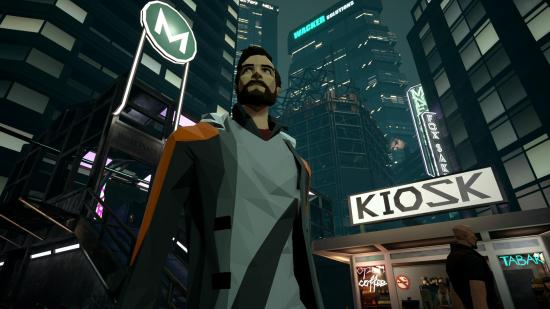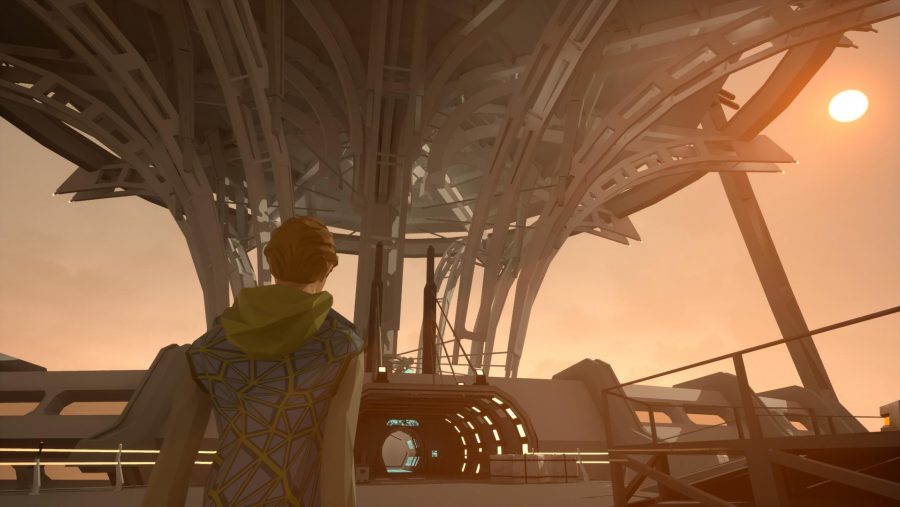I don’t know if you’ve been to Berlin in 2048, but it’s a mixed bag. On the one hand, VR finally happened the way you always wanted – a digital idyll you can dive into, without fear of nausea or tangling your cables. On the other, the real world is now a polluted, permanently surveilled hellhole in which all public sector work is handled by drones and robots. Like I said: pluses and minuses.
It’s against this backdrop that you start Daedalic Entertainment’s new narrative adventure game, State of Mind. As a journalist openly critical of the new surveillance state, you wake up in hospital to find your wife and son have disappeared. Pretty soon, your familial drama transforms into an ambitious story about the juxtaposition between dystopian future and digital paradise.
“I’m working to find new ways to push Daedalic forward for the new times,” producer Kai Fiebig tells us. “We know the adventure genre is a niche market in some ways, but games like Detroit, studios like Quantic and Telltale, they show that you can achieve a huge number of players if you make it right and we’ve tried to start our own formula.”
State of Mind’s story is written by the award-winning German author Martin Ganteföhr. One of Ganteföhr’s greatest contributions to the game wasn’t its dialogue, however, but the inspiration for its aesthetic.
A fractured future
“Ganteföhr had the idea that we can use everything that’s happened in the game in the look,” Fiebig says. “So a shattered person, a shattered society on the edge of change.”
As Daedalic began testing its ideas in Unreal Engine 4, the studio found the initial effect wasn’t pronounced enough. Through iteration, they left photorealism behind and landed on the extreme yet attractive characters you can see in the final game. In contrast to the detailed backgrounds that surround them, protagonist Richard Nolan and the NPCs he encounters have a faceted, polygonal look – as if dropping them onto a hard surface would indeed shatter them into pieces.
“Some people say it looks like PS2,” Fiebig laughs. “If you look at the PS2 pictures there is a difference.”
While the style came together early in development, lighting it was harder. Daedalic wanted to find the right system to reflect the many planes of its character’s facial features just so. To show them off in their best light, you could say.
“The textures are not very complex but we made heavy use of light to make it look more complex than it is,” Fiebig says.
To that end, the studio built a shader – a program that runs in State of Mind’s graphics pipeline and tells your PC how each pixel should be rendered. Once the team had seen the shader at work in Nolan’s Berlin apartment, they knew they had the responsive lighting they were after. But they haven’t stopped working on it since.
“Until the end we were still working on the light,” Fiebig says. “We wanted it to be really unique. It looks like no other game. You cannot really see the lights in screenshots, but if you play the game, if it’s in motion, you can see it looks cool.”
Extreme streaming
Think of level streaming and open world games most likely spring to mind. This is the technology that enabled GTA III and a host of sprawling worlds after it, by smoothly loading and unloading map files in a radius around the player. But it turns out streaming is important in State of Mind, too, and informed Daedalic’s choice of engine.
“That is a feature that comes in Unreal,” Fiebig says. “That gave us the freedom for several people to work on one level in different pieces. It was amazing what you could do with it.”
Fiebig describes a traditional example of how streaming might be used: as you open a door, the room behind it loads in. State of Mind takes this principle to an almost pantomime extreme. If you’re standing in the middle of a busy square, for instance, only the area visible in front of you is streaming. Turn around, and the scene you had just been observing has already disappeared from memory.
The tech proved particularly handy during more complex scenes later in the game. During one sequence in Queens, New York, the game is loading an apartment even as you take the stairs, and then conjuring city streets into being just in time for you to look out of the window.
“It doesn’t look like we’re using streaming in some ways,” Fiebig says,” but it’s heavily used.”
Nolan’s vanished wife and son aren’t simply victims of overzealous level streaming, however. All of this tech is funnelled into a thriller about global conspiracy, where a distinctive look and detailed world sell the themes of surveillance, digital escapism, and transhumanism.
State of Mind is available on Steam from August 15th. Unreal Engine 4 development is now free.
In this sponsored series, we’re looking at how game developers are taking advantage of Unreal Engine 4 to create a new generation of PC games. With thanks to Epic Games and Daedalic Entertainment.





